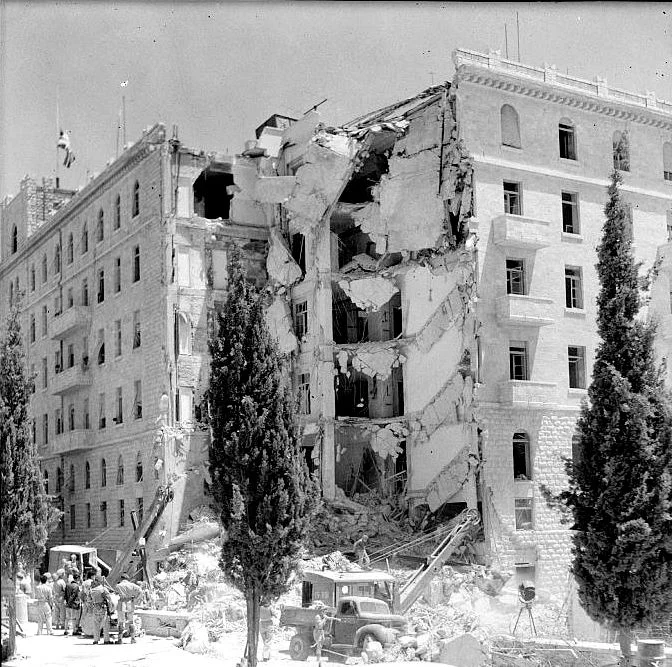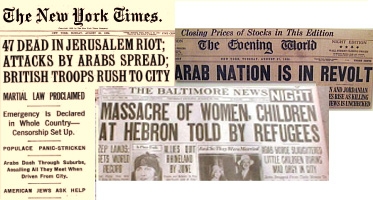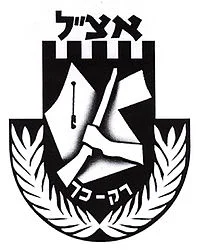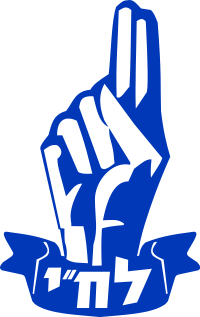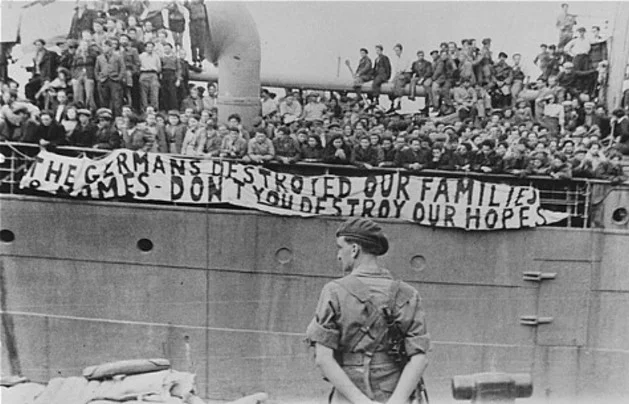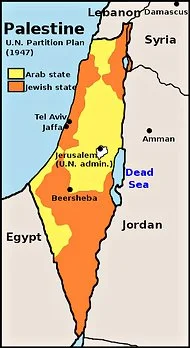JEWISH DEFENSE, RESISTANCE & TERRORISM
Bombing of the King David Hotel, 1946. Photo source: Wikipedia
The Yishuv began developing militias for self-defense in the early 1900s. Known as HaShomer (the Watchman), they mostly protected small settlements in the north from Arab raiders. As time went on and conflict intensified between Jews and Arabs, the Jews developed more sophisticated and organized self-defense groups, primarily the Haganah (the Defense). Though small in number and with limited military experience, these groups proved to be adept at intelligence gathering, reconnaissance, weapons procurement, self-defense, and limited retaliatory strikes. The British Mandate government generally considered them illegal militias, so they mostly stayed underground. They occasionally worked with the British in matters relating to the defense of the Jewish community, or as a fighting force for the British war efforts in World War One and World War Two, such as the Zion Mule Corps during WWI. By the 1940s, the groups were highly sophisticated and deadly.
“The Iron Wall”
The Yishuv was always divided on the use of force, and just how aggressive their self-defense should be against the Arabs. In 1923 Vladimir Jabotinsky wrote a famous essay known as “The Iron Wall.” He argued that the Arabs would never voluntarily accept a Jewish homeland — and Jewish majority — in Palestine. The only way they would accept it, he argued, is if the Jews were so strong they couldn’t be defeated: an “iron wall” of self-defense that the Arabs couldn’t eliminate. Only then could there be peace between the two.
Jabotinsky advocated a maximalist version of Zionism: the most amount of territory, massive and unlimited immigration, and aggressive self-defense. This put him at odds with the mainstream movement so he broke off to form the Revisionist Zionism movement, and founded a separate Revisionist militia: the Irgun.
The 1930s saw increased violence against the Jews. From the horrifying massacres of 1929 came more attacks all over Palestine, as the Arab rebellion gained inspiration from figures like al-Husseini and al-Qassam. The Yishuv struggled to respond.
Restraint
The Haganah, led by David Ben Gurion, advocated a policy called havlagah (restraint). The Jews would respond to violence by defending themselves, but would not initiate violence. In the instance that retaliation was deemed necessary, it would only be directed against the village from where the Arabs had attacked, not against civilians.
Anonymous Soldiers
The Irgun largely rejected the Haganah’s policy of restraint, believing that the Arabs would only respect Jewish strength. They called themselves hayalim almonim — anonymous soldiers, and sought to bring the fight to the Arabs through aggressive acts of self-defense, including retaliation and pre-emptive strikes.
Arab Revolt 1936-39
The Arab Revolt against the British and the Jews saw acts of terrorism from both sides, as the Arabs carried out massacres and the Irgun retaliated. In Tiberias the Arabs set fire to a synagogue, burning everyone to death. In Haifa, following an attack, the Irgun planted a bomb in a market, killing dozens. And on and on.
Photo source: CAMERA
In 1939, to appease the Arabs and end the violence, the British issued the White Paper of 1939, severely restricting Jewish immigration and enraging the Yishuv. From then on the Jews considered the British to be their main enemy. As World War Two began, Ben Gurion iterated a policy, “to fight Hitler as if the White Paper didn’t exist, and to fight the White Paper as if Hitler didn’t exist.” Both the Haganah and the Irgun limited their attacks on the British so as to not harm the war effort. But the Stern Gang, known as the Lehi, had no such restraint, and carried out a limited but campaign of terrorism. From 1939-1947, there was little violence between Jews and Arabs. Once the war ended, however, the Yishuv adopted a campaign of resistance to try to drive the British out of Palestine for good.
Get To Know Your Jewish Militias!
The Haganah (1921) / Palmach (1941)
The Haganah (the Defense) was the “Israeli army” before the Israeli army. The Palmach (Strike Companies) was its special operations branch. The largest of the militias, and associated with the left-wing mainstream Zionist Movement, it reported to David Ben Gurion. It was the most moderate of the militia groups, generally frowning on acts of retaliation and especially abhorrent of the terrorist tactics of the Lehi.
Major figures: David Ben Gurion, Yigal Allon, Moshe Dayan, Yitzhak Rabin, Hannah Senesh
Famous ops: Aliyah Bet
The Irgun (1931)
Founded by Jabotinsky in 1931 as a right-wing alternative to the Haganah, the Irgun favored a much more aggressive posture of self-defense, which included retaliatory strikes against the Arabs. During the 1940s the Irgun waged a campaign of violence against the British in an effort to drive them out of Palestine. Controversial and underground, the Irgun would eventually merge with the Haganah to form the Israel Defense Forces in 1948.
Major figures: Vladimir Jabotinsky, Menachem Begin, the Olei Hagardom
Famous ops: King David Hotel bombing, Acco prison break, the Sergeants Affair
The Lehi (1940)
An ultra-right-wing radical outfit, the Lehi, though very small, carried out a campaign of terrorism against the British. Viewing the British as colonial occupiers whose restrictions on immigration were killing Jews in Europe, the Lehi considered any and all attacks on the British to be justifiable. Also known as the Stern Gang, after its founder, Avraham Stern, the Lehi essentially dissolved after the creation of Israel.
Major figures: Avraham Stern, Yitzhak Shamir
Famous ops: the assassination of Lord Moyne
Beginning in the 1940s, and ramping up after World War Two, the Irgun and the Lehi waged a campaign of resistance (or terrorism, depending on how you want to look at it) against the British occupation of Palestine, which, in light of the White Paper’s restrictions on Jewish immigration, the Yishuv considered unconscionable. In 1944 the Lehi assassinated Lord Walter Moyne, the British Minister of State for the Middle East, at his home in Cairo. The Irgun also conducted a number of sabotage operations to embarass the British military and police, and to demonstrate their ineptitude at providing security.
King David Hotel bombing
By far the most spectacular attack of the Jewish resistance campaign was the Irgun’s bombing of the King David Hotel — Jerusalem’s fanciest hotel, and the headquarters of the British military. Killing 91 people, the King David attack was a huge blow to British morale and commitment to maintaining the Mandate in Palestine. It also deeply divided the Jewish community, many of whose leader’s condemned it.
Aliyah Bet
Meanwhile, the Haganah and the Irgun were engaged in a massive campaign of illegal immigration, in contravention of the White Paper. Hundreds of thousands of Jewish refugees from Europe were smuggled into Palestine during the 1940s, mostly aboard decrepit ships that had to pass a British naval blockade.
The most famous of Aliyah Bet’s operation was the ship Exodus 1947, which captured the attention of the whole world when the Holocaust survivors on board resisted a British boarding party. The British forced the passengers off the boat in Haifa, only to put them on a ship bound back to Europe and, eventually, Germany. The Haganah managed to smuggle most of the survivors back to Palestine. Aliyah Bet highlighted the fact that the British were interning tens of thousands of Jews in harsh conditions in detention camps on Cyprus. A historian referred to the Aliyah Bet operation as “resistance, not by taking lives, but by rescuing them.”
Jewish resistance woked.
By 1947 the British resolved to end the Mandate, and turned the problem of what to do in Palestine over to the United Nations.
On November 29, 1947, the UN voted to partition Palestine into a Jewish state, an Arab state, and an international zone around Jerusalem. This touched off a bloody civil war between Jews and Arabs. In May, 1948, the British left and the State of Israel was established.
UN Partition plan, 1947. Source: the New York Times

